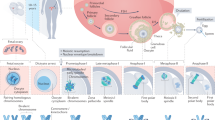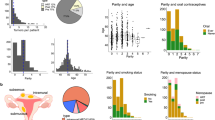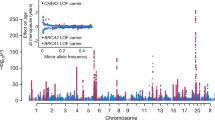Abstract
THE incidence of the human congenital abnormality known as Down's syndrome (or mongolism) has been observed to increase with maternal age1. The trend of sharply increased incidence beyond the age of 30 has been well documented2, and various hypotheses have been formulated to explain it. These include cumulative ovum or uterine dysfunction (radiation3, chemicals4, disease5), acute effects of radiation and chemicals, hormonal effects6, the ‘production line’ hypothesis7,8 and changes in sexual behaviour9. We describe here our hypothesis that there is an interaction between the hormonally governed rate of meiosis and the timing of chiasma terminalisation. We propose that changing hormone levels during the menstrual cycle not only trigger resumption of meiosis in the ovum10, but also control the rate of meiosis through the availability of a limiting substance11. As hormone levels and the length of the cycle change with advancing age of the mother, meiosis slows down, and chiasma frequencies decline7,12. Meiotic chromosome bivalents are held together by their chiasmata against strong mutual repulsion during late dictyotene and diakinesis13, making smaller bivalents with fewer chiasmata, such as 21, the most vulnerable to premature separation during terminalisation14,15; premature separation can lead to trisomy 21, by far the most frequent cytological manifestation of Down's syndrome16.
This is a preview of subscription content, access via your institution
Access options
Subscribe to this journal
Receive 51 print issues and online access
$199.00 per year
only $3.90 per issue
Buy this article
- Purchase on Springer Link
- Instant access to full article PDF
Prices may be subject to local taxes which are calculated during checkout
Similar content being viewed by others
References
Shuttleworth, G. E. Mentally-Deficient Children: Their Treatment and Training (Lewis, London, 1895).
Hook, E. B. & Porter, I. H. (eds) in Population Cytogenetics: Studies in Humans, 353–365 (Academic, New York, 1977).
Siglar, A. T., Cohen, B. H., Lilienfeld, A. M., Westlake, J. E. & Hetznecker, W. H. J. Pediat. 70, 608–611 (1967).
Fialkow, P. J., Marin, G. M. & Sprague, C. A. Am. J. hum. Genet. 25, 317–322 (1973).
Nichols, W. N. Lancet 1, 1059 (1970).
Penrose, L. S. & Smith, G. F. Down's Anomaly (Little and Brown, Boston, 1966).
Henderson, S. A. & Edwards, R. G. Nature 218, 22 (1968).
Henderson, S. A. & Edwards, R. G. in Reproduction and Aging (eds Balazs, A., Nelson-Rees, W. A. & Watiaux, J. M.) 168–181 (M. S. S. Information Corp., New York, 1974).
German, J. Am. Scient. 58, 182–201 (1970).
Ahren, K., Hamberger, L., Herlitz, H., Hillensjo, T., Nilsson, L., Rosberg, S. & Selstam, G. in Biological and Clinical Aspects of Reproduction (eds Ebling, F. J. G. & Henderson, I. W.) 398–437 (Excerpta Medica, Amsterdam, 1976).
Baulieu, E. E., Godeau, F., Schorderet, M. & Schorderet-Slatkine, S. Nature 275, 493–498 (1978).
Luthardt, F. W., Palmer, C. & Yu, P. Cytogenet. Cell Genet. 12, 68–79 (1973).
Darlington, C. D. J. Genet. 21, 207–286 (1929).
Slizyniski, B. Genet. Res. 1, 477–486 (1960).
Yuncken, C. Cytogenetics 7, 234–238 (1968).
Donnell, G. N., Alfi, O. S., Rublee, J. C. & Koch, R. Down's Syndrome (Mongolism): Research, Prevention and Management (eds Koch, R. & Cruz, F. F.) 16–31 (Brunner/Mazel, New York, 1975).
Midgely, A., Zeleznik, A., Rajaniemi, H., Richards, J. & Reichert, L. Gonadotropin and Gonadal Function (ed. Moudgal, N) 416–427 (Academic, New York, 1974).
McNatty, K. & Sawers, R. S. J. Endocr. 66, 391–400 (1975).
Channing, C. P. & Tsafriri, A. Prog. Endocr. Metab. 26, 413–468 (1977).
Sherman, B. M. & Korenman, S. G. J. clin. Invest. 55, 699–706 (1975).
Netter, A. in Aging and Estrogen (eds vanKeep, P. A. & Lauritzen, C.) 143–151 (Karger, New York, 1973).
Rasmussen, H. & Goodman, D. B. P. Physiol. Rev. 57, 421–509 (1977).
Yussman, M., Taymor, M., Migata, J. & Pheteplace, C. Fert. Steril. 21, 119–125 (1970).
Franchimont, P., Legros, J. J., Demoulin, A. & Bourguignon, J. P. Biological and Clinical Aspects of Reproduction (eds Ebling, F. J. G. & Henderson, I. W.) 257–269 (Excerpta Medica, Amsterdam, 1976).
Kennedy, J. F. in Oogenesis (eds Biggers, J. D. & Schuetz, A. W.) 439–457 (Univ. Park Press, Baltimore, 1972).
Lilienfeld, A. M. & Benesch, C. H. Epidemiology of Mongolism (Johns Hopkins Press, Baltimore, 1969).
Croxatto, H. B. et al. in Biological and Clinical Aspects of Reproduction (eds. Ebling, F.J. G. & Henderson, W.) 282–284 (Excerpta Medica, Amsterdam, 1976).
Yussman, M. A. & Taymor, M. L. J. clin. Endocr. 30, 396–399 (1970).
Carr, D. H. Perspectives in Cytogenetics: the Next Decade (eds. Wright, S. W., Crandall, B.F. & Boyer, L.) 75–78 (Thomas, Springfield, 1972).
Daniel, J. C. & Cowman, M. L. Fert. Steril. 17, 804–814 (1966).
Fugo, N. W. & Butcher, R. L. Fert. Steril. 17, 894–914 (1966).
Magenis, R. E., Overton, K. M., Chamberlin, J., Brady, T. & Lovrien, E. Hum. Genet. 37, 7–16 (1977).
Oster, J. Mongolism (Danish Scientific Press, Copenhagen, 1953).
Carter, C. O., Evans, D. A. & Stewart, A. M. 1961. Lancet 2, 1042 (1961).
Collmann, R. D. & Stoller, A. J. ment. Defic. Res. 13, 13–19 (1969).
Halevi, H. S. Br. J. prev. soc. Med. 21, 66–77 (1967).
Lindsjo, A. Acta paediat. scand. 63, 571–576 (1974).
Mikkelsen, M., Fischer, G., Stene, J., Stene, E. & Petersen, E. Ann. hum. Genet. 40, 177–182 (1976).
Lowry, R. B., Jones, J. C., Renwick, D. H. G. & Trimble, B. K. Teratology 14, 29–34 (1976).
Avers, C. J. Basic Cell Biology. (Van Nostrand, New York, 1978).
Hook, E. B. & Chambers, G. M. Birth Defects: Orig. Art. Ser. 13, 123–141 (1977).
Hook, E. B. & Lindsjo, A. Am. J. Hum. Genet. 30, 19–27 (1978).
Author information
Authors and Affiliations
Rights and permissions
About this article
Cite this article
CROWLEY, P., GULATI, D., HAYDEN, T. et al. A chiasma–hormonal hypothesis relating Down's syndrome and maternal age. Nature 280, 417–419 (1979). https://doi.org/10.1038/280417a0
Received:
Accepted:
Published:
Issue Date:
DOI: https://doi.org/10.1038/280417a0
Comments
By submitting a comment you agree to abide by our Terms and Community Guidelines. If you find something abusive or that does not comply with our terms or guidelines please flag it as inappropriate.



